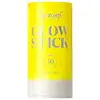What's inside
What's inside
 Key Ingredients
Key Ingredients

 Benefits
Benefits

 Concerns
Concerns

 Ingredients Side-by-side
Ingredients Side-by-side

Butyl Methoxydibenzoylmethane 3%
UV AbsorberEthylhexyl Salicylate 5%
UV AbsorberOctocrylene 10%
UV AbsorberC12-15 Alkyl Benzoate
AntimicrobialCalendula Officinalis Extract
Skin ConditioningCalophyllum Inophyllum Seed Oil
AntimicrobialCaprylic/Capric Triglyceride
MaskingDibutyl Ethylhexanoyl Glutamide
Skin ConditioningDibutyl Lauroyl Glutamide
Skin ConditioningDicaprylyl Carbonate
EmollientDiethylhexyl Syringylidenemalonate
Skin ProtectingHelianthus Annuus Seed Oil
EmollientIsododecane
EmollientIsohexadecane
EmollientLimnanthes Alba Seed Oil
Skin ConditioningMauritia Flexuosa Fruit Oil
Skin ConditioningOctyldodecanol
EmollientPentaclethra Macroloba Seed Oil
EmollientPolyester-8
Skin ConditioningTocopherol
AntioxidantButyl Methoxydibenzoylmethane 3%, Ethylhexyl Salicylate 5%, Octocrylene 10%, C12-15 Alkyl Benzoate, Calendula Officinalis Extract, Calophyllum Inophyllum Seed Oil, Caprylic/Capric Triglyceride, Dibutyl Ethylhexanoyl Glutamide, Dibutyl Lauroyl Glutamide, Dicaprylyl Carbonate, Diethylhexyl Syringylidenemalonate, Helianthus Annuus Seed Oil, Isododecane, Isohexadecane, Limnanthes Alba Seed Oil, Mauritia Flexuosa Fruit Oil, Octyldodecanol, Pentaclethra Macroloba Seed Oil, Polyester-8, Tocopherol
Homosalate 8.5%
Skin ConditioningEthylhexyl Salicylate 5%
UV AbsorberOctocrylene 8.5%
UV AbsorberZinc Oxide 12.1%
Cosmetic ColorantWater
Skin ConditioningCaprylic/Capric Triglyceride
MaskingPropanediol
SolventGlycerin
HumectantCetearyl Olivate
Polyhydroxystearic Acid
EmulsifyingEthylhexyl Methoxycrylene
Skin ConditioningPotassium Cetyl Phosphate
EmulsifyingLauroyl Lysine
Skin ConditioningPhenyl Trimethicone
Skin ConditioningDimethicone
EmollientSorbitan Olivate
EmulsifyingInulin Lauryl Carbamate
Emulsion StabilisingXanthan Gum
EmulsifyingTriethoxycaprylylsilane
1,2-Hexanediol
Skin ConditioningCaprylyl Glycol
EmollientHydroxyacetophenone
AntioxidantPolyester-8
Skin ConditioningDiethylhexyl Syringylidenemalonate
Skin ProtectingCetearyl Alcohol
EmollientMenthone Glycerin Acetal
RefreshingLactic Acid
BufferingArachidyl Alcohol
EmollientChlorphenesin
AntimicrobialCitrullus Lanatus Fruit Extract
Skin ConditioningNiacinamide
SmoothingSodium Stearoyl Glutamate
CleansingCoco-Glucoside
CleansingBehenyl Alcohol
EmollientTrisodium Ethylenediamine Disuccinate
Aloe Barbadensis Leaf Juice
Skin ConditioningSilica
AbrasiveDimethicone Crosspolymer
Emulsion StabilisingArachidyl Glucoside
EmulsifyingSodium Citrate
BufferingParfum
MaskingSodium Hyaluronate
HumectantMagnesium Aspartate
Skin ConditioningZinc Gluconate
Skin ConditioningPhenoxyethanol
PreservativeCopper Gluconate
Skin ConditioningHomosalate 8.5%, Ethylhexyl Salicylate 5%, Octocrylene 8.5%, Zinc Oxide 12.1%, Water, Caprylic/Capric Triglyceride, Propanediol, Glycerin, Cetearyl Olivate, Polyhydroxystearic Acid, Ethylhexyl Methoxycrylene, Potassium Cetyl Phosphate, Lauroyl Lysine, Phenyl Trimethicone, Dimethicone, Sorbitan Olivate, Inulin Lauryl Carbamate, Xanthan Gum, Triethoxycaprylylsilane, 1,2-Hexanediol, Caprylyl Glycol, Hydroxyacetophenone, Polyester-8, Diethylhexyl Syringylidenemalonate, Cetearyl Alcohol, Menthone Glycerin Acetal, Lactic Acid, Arachidyl Alcohol, Chlorphenesin, Citrullus Lanatus Fruit Extract, Niacinamide, Sodium Stearoyl Glutamate, Coco-Glucoside, Behenyl Alcohol, Trisodium Ethylenediamine Disuccinate, Aloe Barbadensis Leaf Juice, Silica, Dimethicone Crosspolymer, Arachidyl Glucoside, Sodium Citrate, Parfum, Sodium Hyaluronate, Magnesium Aspartate, Zinc Gluconate, Phenoxyethanol, Copper Gluconate
 Reviews
Reviews

Ingredients Explained
These ingredients are found in both products.
Ingredients higher up in an ingredient list are typically present in a larger amount.
This ingredient is an emollient, solvent, and texture enhancer. It is considered a skin-softener by helping the skin prevent moisture loss.
It helps thicken a product's formula and makes it easier to spread by dissolving clumping compounds.
Caprylic Triglyceride is made by combining glycerin with coconut oil, forming a clear liquid.
While there is an assumption Caprylic Triglyceride can clog pores due to it being derived from coconut oil, there is no research supporting this.
Learn more about Caprylic/Capric TriglycerideDiethylhexyl Syringylidenemalonate (DESM) is a photostabilizer, antioxidant, and SPF booster.
One of DESM's main roles is stabilizing UV filters, especially avobenzone. Avobenzone is notoriously unstable when exposed to sunlight. By enhancing the stability of these filters, DESM helps maintain the sunscreen's effectivess through wear. It also helps improve protection against long-wave UVA rays by increasing the wavelength of the formula.
Besides enhancing UVA protection, DESM can boost the SPF of high-SPF formulations by up to 5 units.
DESM also preserves the color integrity of cosmetic products and helps reduce the chance of yellowing of fading due to light exposure.
This ingredient is typically found in concentrations between 0.3% - 0.5%. There are currently no maximum usage limits by regulatory bodies.
Though this ingredient is a chemical UV filter, it can often be found in "100% mineral" sunscreens. This is due to regulatory loopholes.
Learn more about Diethylhexyl SyringylidenemalonateEthylhexyl Salicylate is an organic compound used to block UV rays. It primarily absorbs UVB rays but offers a small amount of UVA protection as well.
Commonly found in sunscreens, Ethylhexyl Salicylate is created from salicylic acid and 2-ethylhexanol. You might know salicylic acid as the effective acne fighter ingredient and BHA.
The ethylhexanol in this ingredient is a fatty alcohol and helps hydrate your skin, similar to oils. It is an emollient, which means it traps moisture into the skin.
According to manufacturers, Ethylhexyl Salicylate absorbs UV wavelength of 295-315 nm, with a peak absorption at 307-310 nm. UVA rays are linked to long term skin damage, such as hyperpigmentation. UVB rays emit more energy and are capable of damaging our DNA. UVB rays cause sunburn.
Learn more about Ethylhexyl SalicylateOctocrylene protects skin from sun damage. It absorbs UV-B with peak absorption of 304 nm. It is a common sunscreen ingredient and often paired with avobenzone, a UVA filter. This is because octocrylene stabilizes other sunscreen ingredients by protecting them from degradation when exposed to sunlight. Octocrylene is a photostable ingredient and loses about 10% of SPF in 95 minutes.
Octocrylene also acts as an emollient, meaning it helps skin retain moisture and softens skin. It is oil-soluble and hydrophobic, enhancing water-resistant properties in a product.
Those who are using ketoprofen, a topical anti-inflammatory drug, may experience an allergic reaction when using octocrylene. It is best to speak with a healthcare professional about using sunscreens with octocrylene.
The EU allows a maximum of these concentrations:
Learn more about OctocryleneThis ingredient is also known as Polycrylene. It is a UV photostabilizer and often used in sunscreens as an alternative to octocrylene.
Polycrylene is used to stabilize other UV filters, especially avobenzone, which is known to degrade rapidly without stabilizers. It also absorbs UVB light, but is only about 1/3 as effective as octocrylene.
At its maximum recommended strength of 4%, this ingredient is not likely to make a significant contribution to SPF factor. Polycrylene has a large molecular weight so it's unlikely to penetrate skin.
Although rare, this ingredient can cause contact dermatitis.
Due to regulatory loopholes, you'll be able to find this chemical UV filter in "100% mineral" sunscreens.
Learn more about Polyester-8